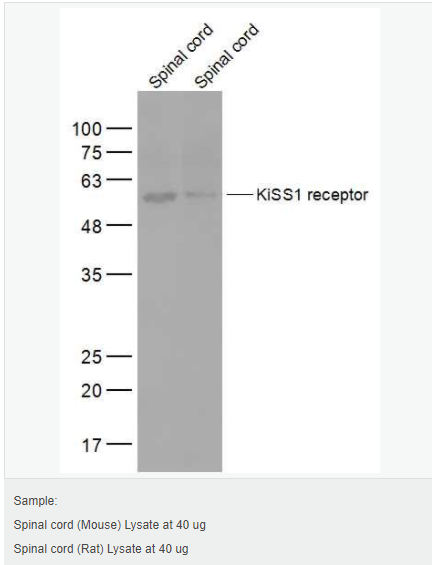

貨號
產(chǎn)品規(guī)格
售價
備注
BN41828R-50ul
50ul
¥1486.00
交叉反應(yīng):Human,Mouse,Rat(predicted:Dog,Pig,Sheep,GuineaPig) 推薦應(yīng)用:WB,ELISA
BN41828R-100ul
100ul
¥2360.00
交叉反應(yīng):Human,Mouse,Rat(predicted:Dog,Pig,Sheep,GuineaPig) 推薦應(yīng)用:WB,ELISA
BN41828R-200ul
200ul
¥3490.00
交叉反應(yīng):Human,Mouse,Rat(predicted:Dog,Pig,Sheep,GuineaPig) 推薦應(yīng)用:WB,ELISA
產(chǎn)品描述
| 英文名稱 | KiSS1 receptor |
| 中文名稱 | G蛋白偶聯(lián)受體54抗體 |
| 別 名 | AXOR 12; AXOR12; G protein coupled receptor 54; G-protein coupled receptor 54; G-protein coupled receptor OT7T175; GPCR 54; GPCR54; GPR 54; GPR54; HOT7T175; Hypogonadotropin 1; Hypogonadotropin-1; Hypogonadotropin1; KISS 1 receptor; KISS 1R; KiSS-1 receptor; KiSS1R; KiSS-1R; KISS1 receptor; KISS1R; Kisspeptins receptor; KISSR_HUMAN; Metastin receptor; OT7T175. |
| 研究領(lǐng)域 | 細(xì)胞生物 免疫學(xué) 神經(jīng)生物學(xué) 信號轉(zhuǎn)導(dǎo) 生長因子和激素 轉(zhuǎn)錄調(diào)節(jié)因子 細(xì)胞膜受體 |
| 抗體來源 | Rabbit |
| 克隆類型 | Polyclonal |
| 交叉反應(yīng) | Human, Mouse, Rat, (predicted: Dog, Pig, Sheep, Guinea Pig, ) |
| 產(chǎn)品應(yīng)用 | WB=1:500-2000 ELISA=1:5000-10000 not yet tested in other applications. optimal dilutions/concentrations should be determined by the end user. |
| 分 子 量 | 44kDa |
| 細(xì)胞定位 | 細(xì)胞膜 |
| 性 狀 | Liquid |
| 濃 度 | 1mg/ml |
| 免 疫 原 | KLH conjugated synthetic peptide derived from human GPR54:121-200/398 <Cytoplasmic> |
| 亞 型 | IgG |
| 純化方法 | affinity purified by Protein A |
| 儲 存 液 | 0.01M TBS(pH7.4) with 1% BSA, 0.03% Proclin300 and 50% Glycerol. |
| 保存條件 | Shipped at 4℃. Store at -20 °C for one year. Avoid repeated freeze/thaw cycles. |
| PubMed | PubMed |
| 產(chǎn)品介紹 | The protein encoded by this gene is a galanin-like G protein-coupled receptor that binds metastin, a peptide encoded by the metastasis suppressor gene KISS1. The tissue distribution of the expressed gene suggests that it is involved in the regulation of endocrine function, and this is supported by the finding that this gene appears to play a role in the onset of puberty. Mutations in this gene have been associated with hypogonadotropic hypogonadism and central precocious puberty. [provided by RefSeq, Jul 2008] Function: Receptor for metastin (kisspeptin-54 or kp-54), a C-terminally amidated peptide of KiSS1. KiSS1 is a metastasis suppressor protein that suppresses metastases in malignant melanomas and in some breast carcinomas without affecting tumorigenicity. The metastasis suppressor properties may be mediated in part by cell cycle arrest and induction of apoptosis in malignant cells. The receptor is essential for normal gonadotropin-released hormone physiology and for puberty. The hypothalamic KiSS1/KISS1R system is a pivotal factor in central regulation of the gonadotropic axis at puberty and in adulthood. The receptor is also probably involved in the regulation and fine-tuning of trophoblast invasion generated by the trophoblast itself. Analysis of the transduction pathways activated by the receptor identifies coupling to phospholipase C and intracellular calcium release through pertussis toxin-insensitive G(q) proteins. Subcellular Location: Cell membrane; Multi-pass membrane protein. Tissue Specificity: Most highly expressed in the pancreas, placenta and spinal cord, with lower-level of expression in peripheral blood leukocytes, kidney, lung, fetal liver, stomach, small intestine, testes, spleen, thymus, adrenal glands and lymph nodes. In the adult brain, expressed in the superior frontal gyrus, putamen, caudate nucleus, cingulate gyrus, nucleus accumbens, hippocampus, pons and amygdala, as well as the hypothalamus and pituitary. Expression levels are higher in early (7-9 weeks) than term placentas. Expression levels were increased in both early placentas and molar pregnancies and were reduced in choriocarcinoma cells. Expressed at higher levels in first trimester trophoblasts than at term of gestation. Also found in the extravillous trophoblast suggesting endocrine/paracrine activation mechanism. DISEASE: Defects in KISS1R are a cause of idiopathic hypogonadotropic hypogonadism (IHH) [MIM:146110]. IHH is defined as a deficiency of the pituitary secretion of follicle-stimulating hormone and luteinizing hormone, which results in the impairment of pubertal maturation and of reproductive function. Defects in KISS1R are a cause of central precocious puberty (CEPREPU) [MIM:176400]. Precocious puberty is defined as the development of secondary sexual characteristics before the age of 8 years in girls and 9 years in boys. Central precocious puberty refers to a gonadotropin-dependent type which results from premature activation of the hypothalamic-pituitary-gonadal axis. Similarity: Belongs to the G-protein coupled receptor 1 family. SWISS: Q969F8 Gene ID: 84634 Database links: Entrez Gene: 84634 Human Entrez Gene: 114229 Mouse Entrez Gene: 100144753 Sheep Omim: 604161 Human SwissProt: Q969F8 Human SwissProt: Q91V45 Mouse Unigene: 208229 Human Unigene: 191035 Mouse Unigene: 48681 Rat Important Note: This product as supplied is intended for research use only, not for use in human, therapeutic or diagnostic applications. |

